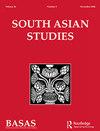A City Besieged and a Love Lamented: Representations of Delhi’s Qila-i Mualla (‘Exalted Fortress’) in the Eighteenth Century
IF 0.7
0 ASIAN STUDIES
引用次数: 0
Abstract
After the devastation of Delhi in the eighteenth century, a new genre of Urdu poetry (shahrashob, ‘the disturbed city’) emerged, lamenting the fallen city and simultaneously marking the displacement of Persian as the language of court poetry. This paper considers two visual laments from this period, focusing on artistic representations that merge structures modelled after the Qila-i Mualla (the Red Fort of Delhi) with narratives of suffering and longing drawn from classical Persian poetry. These responses to Delhi’s endangered existence also register the symbolic importance of a history of sovereign Mughal power associated with the Qila and the now imperiled Persianate cosmopolitan culture from which it developed.一座被围困的城市和一段被悲叹的爱情:18世纪德里“崇高堡垒”的再现
在18世纪德里遭受破坏之后,一种新的乌尔都语诗歌(shahrashob,“被扰乱的城市”)出现了,哀悼这座沦陷的城市,同时标志着波斯语作为宫廷诗歌语言的取代。本文考虑了这一时期的两种视觉哀叹,重点关注了将模仿德里红堡(Qila-i Mualla)的结构与古典波斯诗歌中痛苦和渴望的叙述融合在一起的艺术表现。这些对德里濒临灭绝的回应,也表明了莫卧儿王朝主权历史的象征意义,这段历史与奇拉(Qila)和现在处于危险中的波斯世界主义文化有关。
本文章由计算机程序翻译,如有差异,请以英文原文为准。
求助全文
约1分钟内获得全文
求助全文

 求助内容:
求助内容: 应助结果提醒方式:
应助结果提醒方式:


